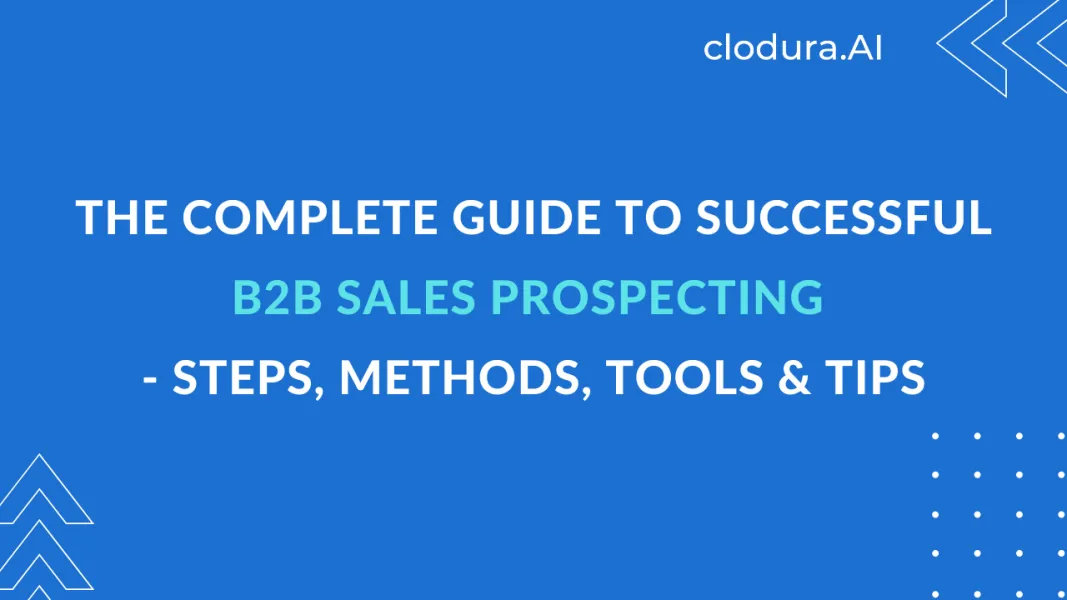You start by locating an area that promises potential gold reserves. Then, you mine for the ores, and when you have enough, you smelt them to separate the gold from the fluff. This gold is further refined and processed to get the most from it. You may have to add value and features to it to increase its worth. Finally, you sell the end-product to the best buyer and make a hefty profit.
Does the process sound similar? You bet it does!
A B2B environment experiences the same while hunting for clients and making sales. Sure, sales prospecting sounds like a back-breaking process, but unless you do it, you won’t strike the purest form of gold!
In this post, we will take a look at everything that you need to know about B2B sales prospecting.
What is Prospecting in the Sales Process?
Let’s reel back to the gold mining reference (I promise, it’s relevant). Back in the days, a prospector was an individual who would manually scan rock formations and creeks to locate gold hotspots. When they identify an area of interest, the prospector would sift through the dirt, wash it, and extract the flecks and nuggets of gold.

Modern-day prospectors are no different! They go through a list of potential customers to locate the ones who may be interested or those ready to buy.
But how do they achieve that? Through Sales Prospecting.
So let us start from the very beginning - What is sales prospecting?
Sales prospecting is the foundational step of any sales process. B2B prospecting strategies encompass researching the market, examining the prospect, and interacting with them. Typically, it involves the following elements:
- Building an ideal customer profile (ICP) or importing the same from the marketing teams
- Using the ICP to identify potential customers, otherwise known as “prospects.”
- Monitoring and identifying digital or market-based opportunities
- Figuring out the best way to approach them; and
- Systematically engaging and communicating with the new prospects to nurture them.
As you can see, all activities that revolve around building a relationship with a potential customer come under the ambit of sales prospecting.
Thus, in a nutshell, strategic Sales Prospecting is the first step in sales, which plays a crucial role in the sales process. It consists of the identification of ideal customer profiles, locating sales opportunities, searching for potential buyers, and reaching out to the prospective leads.
How is Sales Prospecting Different From Lead Generation?
At first glance, it may appear that sales prospecting and lead generations are one and the same thing. Sure, both functions help with the growth of the business. However, they are parts of two separate pipelines, which give varying results. Hence, it is crucial to know the difference between them to identify and employ the best strategy.
Here’s a quick table to help you differentiate between the two:
| Sales Prospecting | Lead Generation |
| Sales prospecting helps connect with targets who may be interested in the products or services that you offer. | Lead generation helps create brand awareness and grow a potential client’s interest in the company. |
| Falls under the responsibility of the Sales Team. | The Marketing Team carries out lead generation. |
| It comes right after lead generation and before pitching. | It is the first step to marketing. |
| It follows a one-to-one approach, that is, it is two-way communication between businesses and customers. | Lead generation follows a one-to-many approach, which means that it is similar to a broadcast or a one-way communication where brands speak to customers but not vice versa. |
| It is a short-term activity as the sales team quickly identify and qualify clients to keep them moving through the sales funnel. | It is a long-term process where marketers work towards establishing a brand image, creating awareness, and engaging with a wide target market. |
| Examples: Emailing, Cold calling, and Social Selling. | Examples: Content marketing, Events, and Account-based marketing (ABM). |
Therefore, while they may be different from each other, these are interlinked processes, and the alignment between the two can maximize your lead capturing and qualifying efforts.
The Importance of Sales Prospecting
“The 30-Day Rule states that the prospecting you do in this 30-day period will pay off for the next 90 days.” ~ Jeb Blount
To truly understand the importance of sales prospecting, let us break it down into two sections - how B2B prospecting benefits your business and the loss resulting due to the lack of it.

Let us first address what it adds to your business:
- More High-Quality Leads: One of the most obvious advantages of prospecting comes in the form of more customers, most importantly, customers who are ready to buy at that very moment. Considering that about 62% of buyers wish to speak to a salesperson during the solution hunting stage, prospecting is the best way to strike the iron while it is still hot.
- Know Your Customer: Through sales prospecting techniques, you can anticipate the customer needs and make a value proposition even before initiating contact. Naturally, if your business drives the client’s profitability and addresses their specific pain points, the prospect would happily convert into a buyer!
- Personalization: In continuation of the above point, it is also pertinent to mention here that it is crucial to stand out in a highly competitive B2B landscape. Having in-depth knowledge about the prospect allows your sales team to tailor their pitch according to the customer.
- Customer-Centricity: In addition to personalizing your pitches and targeted selling, choosing the perfect channel for communication also plays a vital role while establishing contact. Through sales prospecting, you can identify a prospect’s preferred channel of communication, be it cold-calling or outreach through social media.
- Enhanced Sales Productivity: With effective sales prospecting strategies, your sales team would target the right set of people rather than chasing dead leads. Furthermore, it helps them connect with the decision-makers, which shortens the sales cycle. As a result, companies that employ sales prospecting experience higher productivity.
- Market Research: Not all leads will qualify as prospects, and not all prospects will transform into sales. However, the corresponding data collected during the process can lend insights into the target market and consumer behavior. As a result, organizations can make data-driven decisions and re-evaluate their sales and marketing strategies that will help in the long-run.
Now, here’s what you miss out on if you fail to prospect:
- Quick and Effective Lead Qualification: It is no secret that high-quality leads result in more revenue. Prospecting sets the bar for qualification, and failure to do so will result in wasted efforts and resource allocation to unfit prospects.
- Sales Pipeline Management: On average, a salesperson typically loses about 15 to 20 percent of clients (per annum) from the customer base due to gradual attrition. Thus, it is essential to continue filling these gaps through constant sales prospecting to reach out to a larger customer base and ensure continuity. As they say, “pipeline is the lifeline,” and the lack of sales prospecting could result in an eroded database and outdated practices!
- Attractive Revenue-Generation Opportunities: According to Gong’s data science team, salespeople rush to make an eleventh-hour sale to reach their quota, and the success rate of these calls are the lowest. Thus, employing sales prospecting methods right from the start can help avoid this rush.
- Streamlined Sales Cycle: Shockingly, according to Implicit Insights, it takes 84 days to transform a qualified lead into a beneficial sales opportunity, followed by an additional 18 days to secure the deal! Moreover, it takes nearly 18 calls to connect with an actual buyer! However, businesses can bypass this long-drawn struggle through prospecting as it allows salespeople to prioritize leads based on several factors.
Major Sales Prospecting Challenges Faced by Salespeople
According to HubSpot, over 40% of salespeople agree that sales prospecting is the most challenging part of the entire sales process. Anyone who has spent enough time in sales knows this statistic to be true. In fact, it is safe to assume that B2B sales prospecting issues outweigh the challenges posed by closing sales, identifying leads, and qualifying leads collectively!
But what is it that makes sales prospecting difficult? Here’s an overview:
- Lack of Prospecting Awareness
So, by now you may have figured out that prospecting is kind of a big deal. However, the problem starts when your sales team is unaware of it. The sheer challenge posed by sales prospecting is one of the greatest deterrents of prospecting. So much, that according to RAIN Group, a whopping 66% of salespeople do not have the time or energy to put into prospecting. Clearly, this issue could culminate in a greater problem!
While top sales performers are embracing sales prospecting, motivating others to follow a similar route is one of the greatest challenges that organizations face. Plus, prospecting is not as easy is merely selecting any random prospecting strategies and praying that it would work. What is required is strategic prospecting, and there are not many takers who wish to invest their time in it when there are pressing targets to meet!
Simply put, salespeople lack the motivation to carry out a task as intensive as B2B prospecting. The best possible way to overcome this issue is to introduce an excellent sales prospecting tool that not only complements their efforts but gets the job done!
- Failure to Create a Prospecting Strategy
Would you step into a boxing ring without knowing how to throw a punch?
So, how would you go about establishing a sales prospecting workflow without having a working knowledge of the various sales prospecting methods? The purpose of strategic prospecting is to employ sales prospecting techniques that work.
The first phase of setting up an effective prospecting strategy starts with sourcing real-time and actionable sales intelligence. Having this data at hand will enable the salespeople to identify buying triggers, which is a part of the larger problem. Companies can seek the aid of tools that carry out the bulk of the research, set priorities, and offer customizable triggers for the company’s area of interest.
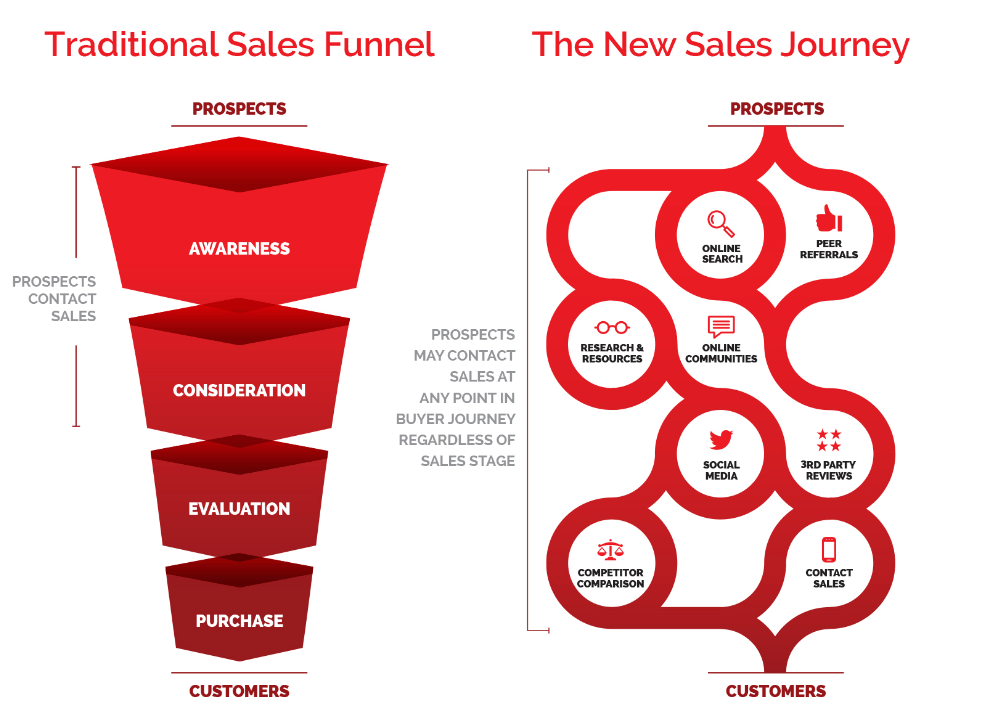
Following this, salespeople need to access the research data and work towards a channel of communication. Typically, a triple touch strategy could accelerate a prospect’s response. Remember, nobody is a fan of bulk emails or messages, so invest time and effort to customize your pitches and make them personal.
It is worth noticing that it takes six to eight touches to make a sale. So even after you have set off the communication chain, follow up and continue to engage with the customers. Depending on these interactions, you could review and reassign priorities for prospects that have more potential to convert into long-term customers. At the same time, salespeople should also keep an eye out to detect and capitalize on any buying triggers that may dynamically emerge.
The above is just a barebones overview of what your sales prospecting strategy should look like. In the latter half of this post, we will discuss sales prospecting steps at length.
- Improper Targeting
Poor targeting is yet another problem that salespeople encounter while prospecting. Nearly 41% of prospectors fail to target the right people, while 43% of salespersons target too low in the organization (RAIN Group).
Salespeople are guilty of perceiving gatekeepers as annoying obstacles. Rather than working around them, they need to deal with them productively and work with them. Considering that they are the guys on the inside, and the ones who know the ins and outs of the business, they can offer you invaluable nuggets of information. Dismissing them would simply result in an untapped opportunity.
On the other hand, you might find advocates and develop them into brand champions within the target organization. However, if you fail to reach out to the ultimate decision-makers, it will essentially nullify your efforts. A good practice to avoid getting stuck in this situation is to follow a top-down approach than otherwise. Contacting the C-level and getting their referral will not only help you reach the big bosses but also earn you an impactful referral on the way.
- Poor Quality of Leads
Sales and marketing may be two different entities, but that does not mean that they are independent of each other. In fact, the secret to successful sales prospecting and high-quality lead generation lies in sales and marketing alignment through blurring out the exclusivity. It not only drives the bottom line but also creates a better user experience.
However, feeding poor quality leads to the sales funnel will only bring down the productivity of the sales team. As a result, even your top-performing salespeople will find themselves engaged in non-productive prospecting, which will cause a drain on their time, efforts, and resources. The resultant frustration will again make them detest prospecting and cause them to fall short on their quota, which is basically a vicious circle.
Therefore, the best way to address this issue is to employ tools that can generate high-quality leads through marketing intelligence.
- Inability to Land Sales Appointments
One of the greatest myths in sales is that it is impossible to land meetings. On the contrary, 82% of buyers are willing to meet with sellers who proactively reach out! However, in this case, it can be a bit of a problem to break through all the marketing noise and sales prospecting techniques used by your competitors.
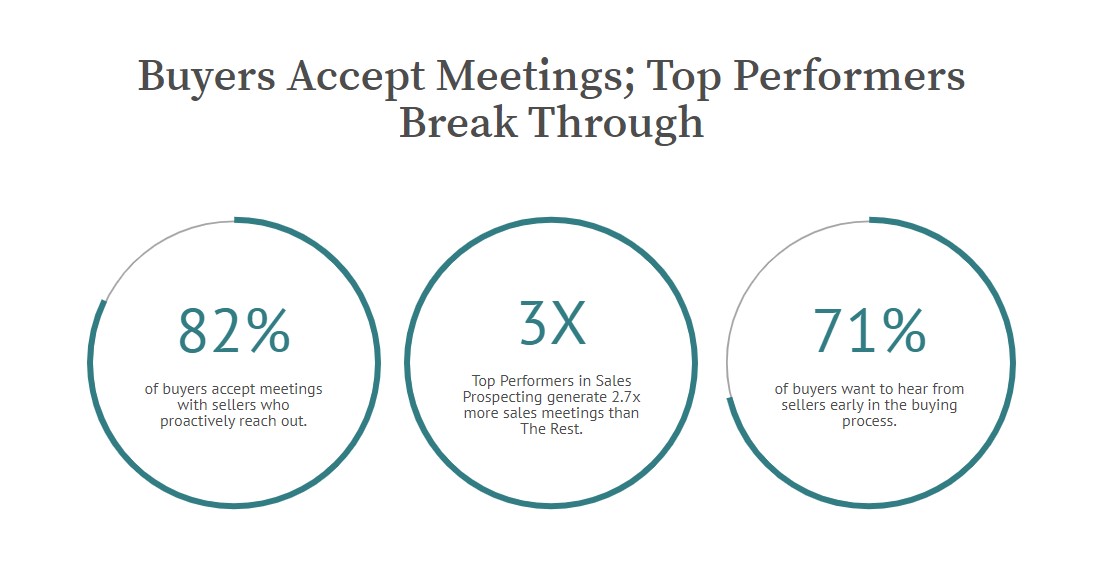
The first actionable step to tackle this issue should be in the form of using market insights to review your prospecting strategies and select the best out of these. Next, to complement the B2B prospecting methods, marketers and salespeople should target and retarget buyers, and they move in and out of the sales funnel. As you must have noticed, the stat says, “proactively reach out,” which means that you will not only have to follow-up, but you will have to do it often! When it comes to prospecting, persistence is the name of the game, and giving up too early would only mean accepting defeat!
Thus, your teams need to be tenacious until you bag an appointment with the buyer.
READ NOW: The Best B2B Sales Prospecting Methods, Strategies, and Tools to Close More Deals
Guide to B2B Sales Prospecting: A Step-by-Step Approach
According to HubSpot, 50% of sales time gets spent on unproductive prospecting. To avoid falling into that rut here is an elaborate step-wise guide on B2B sales prospecting:
- Identify Your Total Addressable Market
Before you take on this expedition, it is crucial to get your treasure map in place. Researching the market is the most vital aspect of sales prospecting. For instance, if you are in the fashion industry, you wouldn’t suggest women apparel to a bodybuilder!
Hence, the first step is to define your total addressable market (TAM). TAM demonstrates the overall revenue opportunity that exists within the market for a product or service. It helps determine the viability of your offering and the target audience for it. Depending on the nature of your business, you can choose any one of the four TAM calculation methods to gain market insights. Alternatively, there are several automated tools available that can carry out this research.
- Create an Ideal Customer Profile
Once you have defined your target market, it is time to sift out the organizations that truly matter. For this purpose, your team will have to create an Ideal Customer Profile (ICP). An ICP is a hypothetical company that would have been the focus of all sales and marketing activities. It acts as a standard base against which companies and compare and contrast the prospects. Naturally, the one that fits the mold is more likely to convert. So why waste your resources on a damp squib?
READ NOW: How to Create Your Ideal Customer Profile for Sales Outreach
Companies can describe their top customers on the basis of factors like industry sector, company goals or pain points, geography, size, and budget. Furthermore, inputs collected from existing clients also contribute to creating an ICP. Overall, ICP lends direction to your sales and marketing team, thereby boosting their effectiveness in identifying high-quality leads.
- Generate High-Quality Leads
While defining your ICP, you have started laying the foundation for generating high-quality leads. It goes without saying that every minute that your salesperson spends on a cold or dead lead is tantamount to a loss in revenue and poor allocation of resources.
Your existing customer base is one of the best places to start hunting for high-quality leads. Identify your best customers and locate the common denominator. Do the same for your worst clients. It will offer you an insight into which lead generation channels work well for you, and which fail to serve their purpose.

At the same time, it is wise to research your ICP to filter out the markers that will help you differentiate a good lead from a bad one. With these discoveries, you have a system in place that can guide the lead generation system!
READ NOW: How to Build Your B2B Contact List with Emails and Direct Dials
- Collect Sales Intelligence Data
We are living in an era of smart prospecting, and intelligent data is the fuel driving this change. Thus, it would be foolish to miss out on opportunities that leverage data to drive sales and marketing decisions.
Sales intelligence, right from technographic data to a list of key personnel and decision-makers of a company, can help you predict or identify any market opportunity and capitalize on it. Through various sales intelligence metrics, your sales team can bring their A-game while monitoring prospects in real-time, staying up to date on all the happenings, prioritizing prospects, and pushing for sales.
Here is an example of How We Sky-Rocketed our Email Campaign Reply Rates Using Technographics. Watch the video below to learn more.
However, it is worth noting here that merely constructing a systematic database is not enough. Companies need to maintain this database to ensure relevance and data hygiene periodically.
- Craft a Sales Pitch for the Perfect Outreach
After laying all the groundwork, now comes the fun part - pitching!
Sales prospecting is not about you, your company, or your product; it is about the prospect. So try and incorporate as much value as you can during the first contact.
The sales pitch must be a perfect blend of all your research and your charm. Thus, dedicate the time to get it right. Once you have created the first draft of your sales pitch, go over it again and again until you have a refined end product. It needs to be relevant, timely, and specifically address your prospect’s problems. At the same time, make sure to keep it fun and casual while also including your personality as you craft your sales pitch. Nobody wants a robot reading out a script!
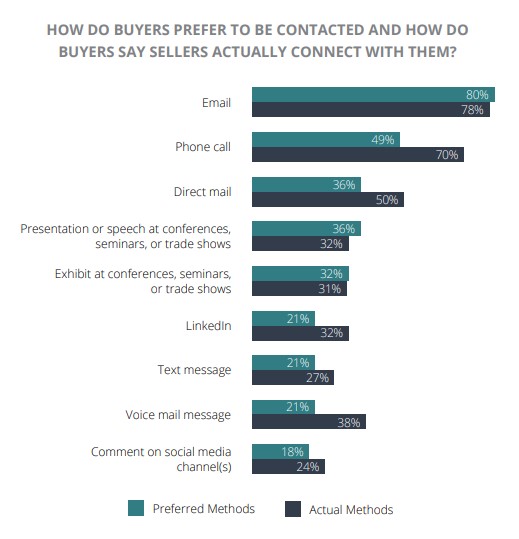
Next, use your client information to pick the perfect communication channel. Irrespective of the B2B sales prospecting methods, the outreach must always be customized according to the prospect. Let’s keep it personal!
- Follow-up and Schedule Meetings
Sure, you may have made a stellar first impression. However, do not be disheartened if you notice the prospect stagnating in the sales funnel. So how do you keep the conversations flowing? Through follow-ups!
Pursuing a prospect does not necessarily mean that you have to stick to the same mode of contact. You can try to diversify the channels to encourage a response from the prospect. Stay persistent (without being annoying) and try to schedule a meeting. As we discussed earlier, as long as the buyers perceive you as valuable, they will not only agree to meet but will also more likely convert into sales wins!
So, get proactive and block a date on your prospect’s planner!
- Educate and Qualify Prospects
Now that you have established contact with your prospect, it is time to take one hard look at your prospect. Consider everything that you know about them, their location, decision-making process, organizational requirements, pain points, competition, etc. This is the last stage of qualifying the prospect and matching them to your ICP before you invest time in nurturing them.
It is possible that you can push hard and land a sale. However, bad-fit sales will only result in unhappy customers and negative experiences.
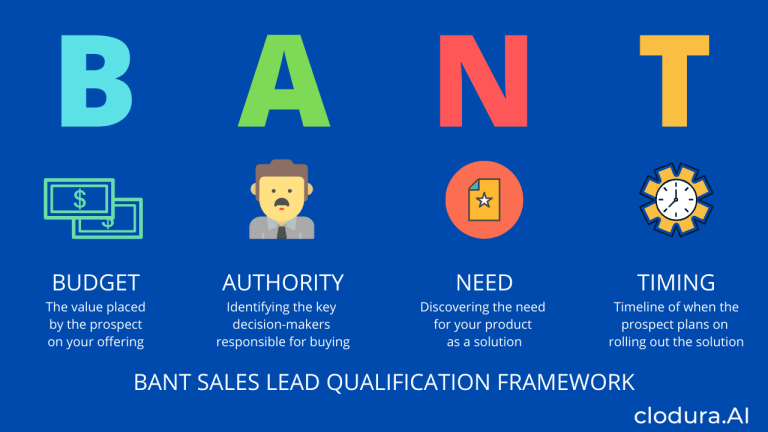
Once you are satisfied that the prospect qualifies, add value to every touchpoint. Start by addressing their pain points and how your product or service is an apt solution for it. Sell them what they want. You can then move on to introduce case studies of similar clients, videos, how-to guides, market research reports to reel them in.
- Handle Sales Objections Like a Pro!
According to Marketing Donut, about 80% of prospects say “no” four times before it gets converted into a “yes.”
So what differentiates the fourth “no” from the “yes”? Sales objection.
And how can you deal with it? Simple, erasing the fundamental doubt that is acting as an obstacle in the way.
Sales objection is not a new concept. However, how you handle the sales objections could steer the conversation uphill or downhill. You don’t have to be a veteran salesperson to know how to deal with objections; you only have to be thoroughly prepared. Anticipating the sales objection and crafting an appropriate response can help your prospect make up their mind.
- ABC - Always Be Closing
Congratulations on making it this far! Now, it is only a matter of time to do what you came for - Close!
One of the greatest cardinal sins in sales is not asking for the sale. If you ask too soon, the fear of rejection looms ahead. However, if you delay closing a deal, a competitor swoops in and devours your lead.
The best technique for closing a deal is explicitly asking for a sale. There is no sugarcoating this fact. Even if you receive a “no” as an answer, follow up with questions to get to the root of the objection and overcome it. However, if you end up in a stalemate, then take it in your stride and move on. It is a valuable learning experience to know when to give up!
READ NOW: Guide to Handling Objections in Sales – Tips on Overcoming the Most Common Sales Objections
Best Sales Prospecting Techniques
“There is no easy button in sales. Prospecting is hard, emotionally draining work, and it is the price you have to pay to earn a high income.” ~ Jeb Blount

Let us take a look at the top B2B prospecting methods that can enhance your sales and marketing efforts:
Nearly 41% of B2B buyers wish to be contacted over emails, making it the most preferred channel for communication. But that’s not all, according to a survey by Aberdeen, personalized emails attract a 14% increase in their click-through rates and a 10% increase in conversions.
- Cold Call
“Cold calling is dead!”
You may have come across articles sensationalizing the demise of cold calling, but guess what? After email, calling is the second-most effective sales prospecting techniques that continue to stay relevant.
So don’t get cold feet on making that cold call.
READ NOW: 20 B2B Cold Calling Tips to Generate More Meetings
- Referral
In a B2B environment, referrals are a golden opportunity waiting to be exploited. A referral is an indication that a client is impressed by your services and recommends it to their peers. Thus, you need to offer more than a sale to count as a trusted resource, which means robust after-sale services!
Fortunately, all the good karma will pile on as you use these referrals to introduce your company to a new prospect.
- Conferences
Exhibits at seminars, trade shows, and conferences are one of the oldest sales prospecting strategies in the book. Start by listing out the right events that are worth attending. Get a hold of the guest list and the agenda to formulate a networking strategy.
- Webinars
An attendee who has shown an interest in your webinar indicates their interest in the topic. Thus, webinars are the best place to establish your brand as a thought leader or a domain expert. Capitalize on the opportunity by including a poll at the end of the webinar to capture the details of those who wish to know more.
- Social Selling
Social media is teeming with potential prospects. Hence, it is no surprise that social selling is a worthy up and coming trend. Considering that buyers are already researching sellers, you can meet them halfway. Still on the fence about social selling? Consider this - B2B sellers who use social selling are 72% more likely to exceed their quotas.
Tried and Tested Sales Prospecting Tips
Here are some sales prospecting tips that will help you acquire more customers:
- Rejection is a part of the game. One of the biggest mistakes that you can make is giving up too soon. So try to stay consistent during your sales efforts.
- Mistakes are inevitable. Transform the failure into a learning opportunity so that you can hone your selling skills.
- Maintain a steady pipeline to ensure that you keep up the sales velocity.
- While it may be tempting to overpromise or exaggerate the benefits of your product, it is essential to stay honest. Sales success should not come at the cost of a customer’s trust.
- Try complementing your sales prospecting techniques with inbound operations, and they will add to the common goal of qualifying, growing, and nurturing the pipeline.
- Keep your prospects engaged by making interim offers that may nudge their decision in your favor.
- It pays to be helpful. In addition to adding value at every touchpoint, use social media to nurture trusting and long-term relationships with clients and prospects.
- We cannot stress upon this enough, choose B2B prospecting tools according to your business model. These tools offer a handsome ROI and will boost your efficiency right through the roof!
- Selling is a tough job. So make it a point to celebrate the wins, no matter how small.
- Finally, be unafraid to experiment with different B2B prospecting methods to improve your overall strategy.
Top Sales Prospecting Tools
To drive your lead qualification, sales prospecting, and prospect management processes, consider the following tools that can come handy at different stages of sales prospecting:
1- LinkedIn
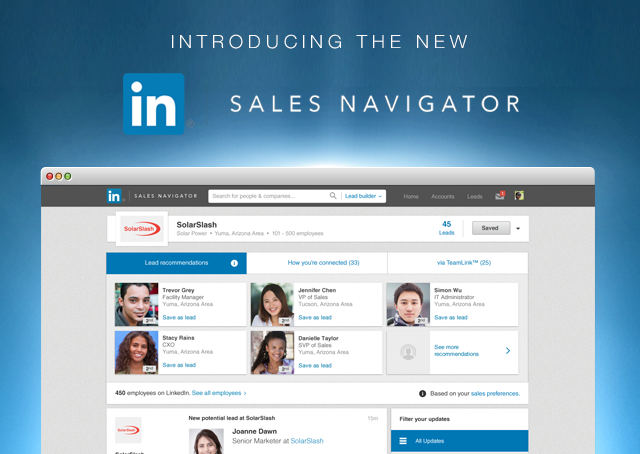
LinkedIn and its Sales Navigator is the tool that can help you source high-quality and relevant information on your prospect. And the best part? It is absolutely free! Plus, it is a great way to introduce yourself to a prospect.
LinkedIn comes with advanced search capabilities that allow you to enter specific keywords, such as company name, personnel name, or role title, in the search bar. The filtering feature allows users to narrow down the result to a single individual!
After you have located your contact, you can make use of the Sales Navigator sidebar to populate the account-associated user information right to your inbox!
2- Clodura

sales prospecting platform that can accelerate your lead-to-meeting journey. It can carry out a wide array of actions such as identifying Total Addressable Market, generating high-quality leads, generating sales intelligence in real-time, crafting sales pitches, and automating sales sequences and follow-ups.
Powered by its AI capabilities, Clodura gathers sales intelligence data and offers actionable insights for customizable sales triggers. Clodura offers you a competitive edge that allows you to extract the most from your sales and marketing activities.
3- CrunchBase
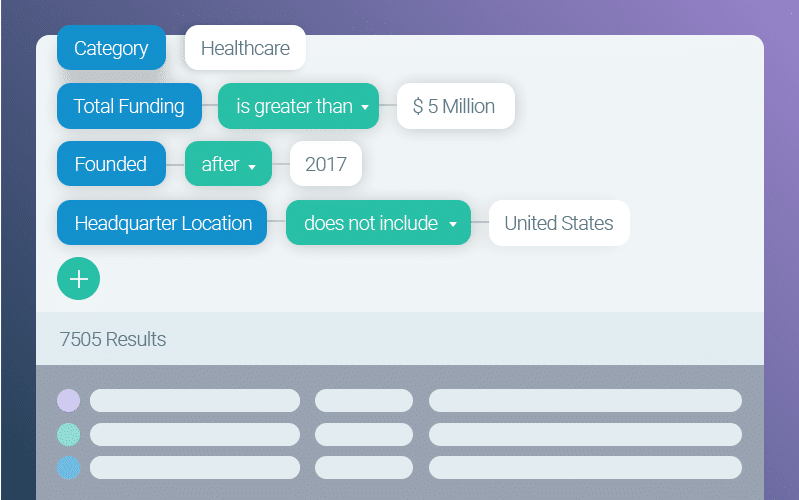
CrunchBase is a widely popular platform to discover ongoing industry trends. It is a repository of all the details of public and private companies located over the world! So whether you are looking for Fortune 500 companies or budding startups, Crunchbase grants you access to all the details that will allow you to gain new prospects. While free users can add two filters, pro users can use as many as 25 filters to make their search more granular and specific.
In addition to scoring new prospects, CrunchBase can also help you stay updated on all the latest news and happenings, which may help identify sales triggers.
4- Owler

“Keep your friends close and enemies closer.”
In a B2B landscape, it is vital to keep a close eye on your competitors. Owler allows you to do just that! It not only allows you to analyze your competitor’s strategies but also helps you target their prospects even before they are ready. Owler’s features, like Daily Snapshot and Instant Insights, allow you to track other companies and receive customizable alerts about them.
5- Calendly
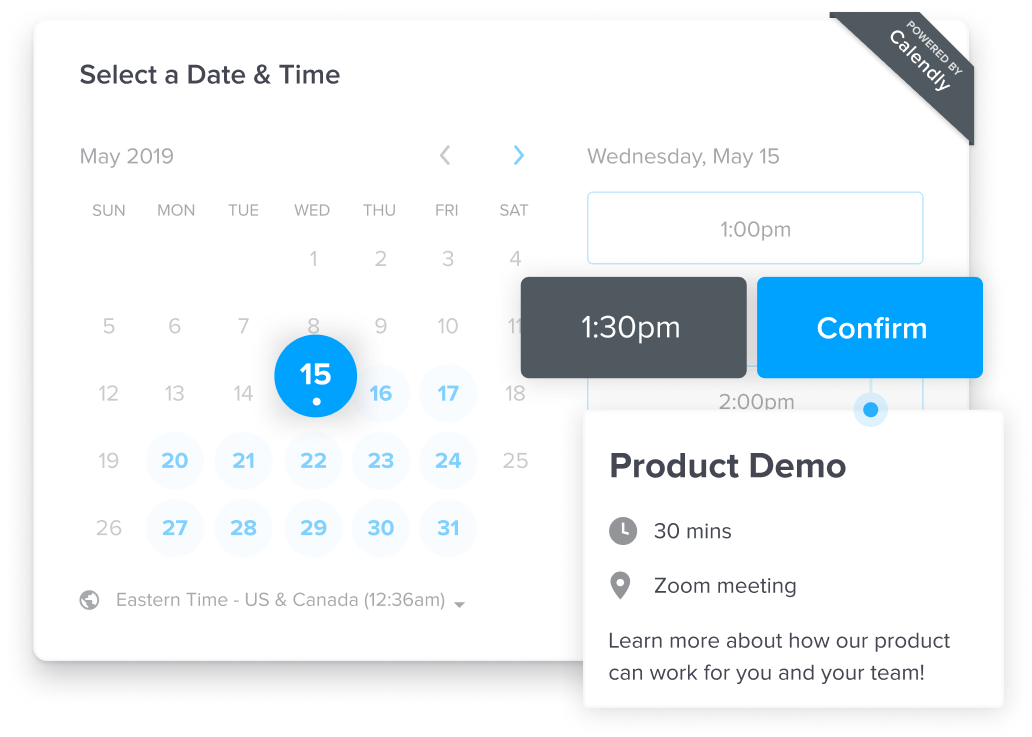
Remember when we asked you to make an appearance in your prospect’s planner? Calendly will get you there!
It allows your business to connect with leads. You can transform the lookers into bookers by scheduling meetings in real-time and in accordance with the local time zone. Including a Calendly link in your emails as a CTA is an effective outbound marketing strategy that can help you easily engage and convert prospects. Plus, once the user has scheduled a meeting, Calendly follows up by reminding them of the upcoming meeting, thereby reducing no shows at the meeting!
6- Mailtrack

Sometimes, silence speaks louder than words.
However, in the world of email marketing, silence could either mean that the client is not interested in your mails and is ignoring them or not opening them at all! Mailtrack can differentiate between the two. It helps in sending out fewer but more meaningful messages and follow-ups. You can modify your outreach depending on the kind of response offered by the receiver.
7- Boomerang
Are you too busy to send out an email at a specific time? Then Boomerang could be the perfect tool for you! It allows you to schedule emails for a later time. Furthermore, it provides follow-up reminders and lets you know when your emails have been opened. You can even track which links in your email have been opened, and which ones have been ignored. The basic plan of Boomerang is free, but you can also enjoy a 30-day free trial.

READ NOW: 10 Best Sales Prospecting Software Tools To Manage Remote Sales in 2020
Putting it all Together
The success of any business depends on sales, and sales require a full pipeline. The ultimate way to grow a pipeline of well-qualified leads is through constant sales prospecting. It is worth noting that sales prospecting is not a standalone process. It is a series of actionable steps where one thing leads to another.
However, there is no standard blueprint that can help you achieve the desired outcome. For best results, you need to try out different sales prospecting techniques and mix it up with various outreach methods. Try out different prospecting strategies, measure the results, and continue improving it. Interestingly, your team’s prospecting skills will get better with practice.
Use the tips and best practices outlined above to stay at the forefront of your prospect’s mind. Soon enough, you will notice a significant improvement in your bottom line.
So go on and claim your pot of gold through prospecting!
